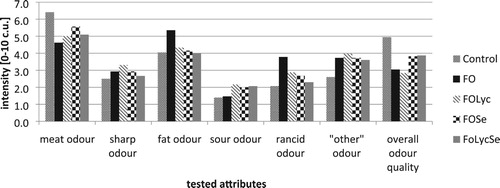Figures & data
Table 1. Division of experimental groupsTable Footnotea due to the way of feeding, chemical composition the basal diet (BD), highly selenized yeast (SeY), sunflower oil (SO) and odourless fish oil (OR).
Table 2. Comparison of average feed intake, feed conversion ratio (FCR), body weight gain (BWG) of rabbits and longissimus thoracis muscle mass of the studied groups of rabbits (♀ = 5; ♂ = 5; Σ(♀ and ♂) = 10) at 90 days of life (i.e. after 55 days of experiments on rabbits).
Table 3. The concentration sums (mg/g) of saturated fatty acids (ΣSFAs)Table Footnotea, atherogenicTable Footnoteb (ASFA) and thrombogenicTable Footnotec (TSFA) saturated fatty acids, monounsaturated fatty acids (ΣMUFAs)Table Footnoted, polyunsaturated fatty acids (ΣPUFAs)Table Footnotee, all assayed fatty acids (ΣFAs), Σn-3PUFAs (Σn-3), Σn-6PUFAs (Σn-6) and the ratio of Σn-6 to Σn-3 (Σn-6/Σn-3) in the longissimus thoracis muscle of rabbits.
Figure 1. Average concentration of malondialdehyde (MDA) in meat samples [mg/kg product] in the test groups (n = 10). a, b – means marked with different letters differ significantly at P < 0.05.
![Figure 1. Average concentration of malondialdehyde (MDA) in meat samples [mg/kg product] in the test groups (n = 10). a, b – means marked with different letters differ significantly at P < 0.05.](/cms/asset/4dc8f897-68cd-4c35-9408-344ee95b130e/taar_a_1828893_f0001_oc.jpg)
Figure 2. Comparison of sensory quality of odour notes of rabbit meat in the experimental groups (n = 50).

Table 4. Values of correlation coefficients (r) between the analyzed variables (n = 50).
